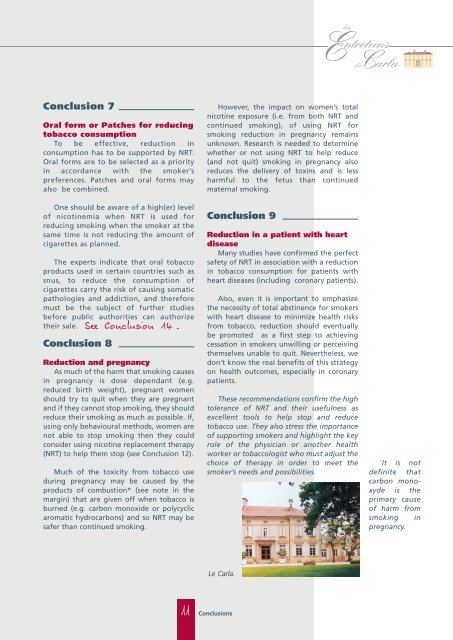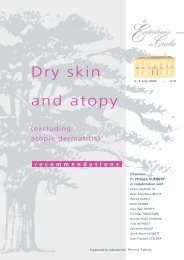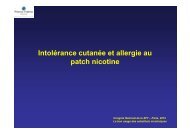Nicotine replacement therapy … - Carlos A ... - Entretiens du Carla
Nicotine replacement therapy … - Carlos A ... - Entretiens du Carla
Nicotine replacement therapy … - Carlos A ... - Entretiens du Carla
Create successful ePaper yourself
Turn your PDF publications into a flip-book with our unique Google optimized e-Paper software.
Conclusion 7<br />
Oral form or Patches for re<strong>du</strong>cing<br />
tobacco consumption<br />
To be effective, re<strong>du</strong>ction in<br />
consumption has to be supported by NRT.<br />
Oral forms are to be selected as a priority<br />
in accordance with the smoker’s<br />
preferences. Patches and oral forms may<br />
also be combined.<br />
One should be aware of a high(er) level<br />
of nicotinemia when NRT is used for<br />
re<strong>du</strong>cing smoking when the smoker at the<br />
same time is not re<strong>du</strong>cing the amount of<br />
cigarettes as planned.<br />
The experts indicate that oral tobacco<br />
pro<strong>du</strong>cts used in certain countries such as<br />
snus, to re<strong>du</strong>ce the consumption of<br />
cigarettes carry the risk of causing somatic<br />
pathologies and addiction, and therefore<br />
must be the subject of further studies<br />
before public authorities can authorize<br />
their sale. See Conclusion 14.<br />
Conclusion 8<br />
Re<strong>du</strong>ction and pregnancy<br />
As much of the harm that smoking causes<br />
in pregnancy is dose dependant (e.g.<br />
re<strong>du</strong>ced birth weight), pregnant women<br />
should try to quit when they are pregnant<br />
and if they cannot stop smoking, they should<br />
re<strong>du</strong>ce their smoking as much as possible. If,<br />
using only behavioural methods, women are<br />
not able to stop smoking then they could<br />
consider using nicotine <strong>replacement</strong> <strong>therapy</strong><br />
(NRT) to help them stop (see Conclusion 12).<br />
Much of the toxicity from tobacco use<br />
<strong>du</strong>ring pregnancy may be caused by the<br />
pro<strong>du</strong>cts of combustion* (see note in the<br />
margin) that are given off when tobacco is<br />
burned (e.g. carbon monoxide or polycyclic<br />
aromatic hydrocarbons) and so NRT may be<br />
safer than continued smoking.<br />
11<br />
However, the impact on women’s total<br />
nicotine exposure (i.e. from both NRT and<br />
continued smoking), of using NRT for<br />
smoking re<strong>du</strong>ction in pregnancy remains<br />
unknown. Research is needed to determine<br />
whether or not using NRT to help re<strong>du</strong>ce<br />
(and not quit) smoking in pregnancy also<br />
re<strong>du</strong>ces the delivery of toxins and is less<br />
harmful to the fetus than continued<br />
maternal smoking.<br />
Conclusion 9<br />
Re<strong>du</strong>ction in a patient with heart<br />
disease<br />
Many studies have confirmed the perfect<br />
safety of NRT in association with a re<strong>du</strong>ction<br />
in tobacco consumption for patients with<br />
heart diseases (including coronary patients).<br />
Also, even it is important to emphasize<br />
the necessity of total abstinence for smokers<br />
with heart disease to minimize health risks<br />
from tobacco, re<strong>du</strong>ction should eventually<br />
be promoted as a first step to achieving<br />
cessation in smokers unwilling or perceiving<br />
themselves unable to quit. Nevertheless, we<br />
don't know the real benefits of this strategy<br />
on health outcomes, especially in coronary<br />
patients.<br />
These recommendations confirm the high<br />
tolerance of NRT and their usefulness as<br />
excellent tools to help stop and re<strong>du</strong>ce<br />
tobacco use. They also stress the importance<br />
of supporting smokers and highlight the key<br />
role of the physician or another health<br />
worker or tobaccologist who must adjust the<br />
choice of <strong>therapy</strong> in order to meet the<br />
smoker’s needs and possibilities.<br />
Le <strong>Carla</strong>.<br />
Conclusions<br />
* It is not<br />
definite that<br />
carbon monoxyde<br />
is the<br />
primary cause<br />
of harm from<br />
smoking in<br />
pregnancy.






